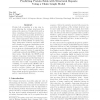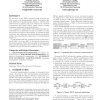886 search results - page 107 / 178 » On the Autoreducibility of Random Sequences |
ICML
2005
IEEE
14 years 8 months ago
2005
IEEE
Protein fold recognition is a key step towards inferring the tertiary structures from amino-acid sequences. Complex folds such as those consisting of interacting structural repeat...
DOCENG
2003
ACM
14 years 1 months ago
2003
ACM
We introduce a lazy XSLT interpreter that provides random access to the transformation result. This allows efficient pipelining of transformation sequences. Nodes of the result tr...
ICALP
2001
Springer
14 years 8 days ago
2001
Springer
Abstract. We consider the sequence comparison problem, also known as “hidden pattern” problem, where one searches for a given subsequence in a text (rather than a string unders...
STOC
1993
ACM
13 years 12 months ago
1993
ACM
We analyze algorithms that predict a binary value by combining the predictions of several prediction strategies, called experts. Our analysis is for worst-case situations, i.e., we...
FOCS
1995
IEEE
13 years 11 months ago
1995
IEEE
Abstract. Littlestone developed a simple deterministic on-line learning algorithm for learning k-literal disjunctions. This algorithm (called Winnow) keeps one weight for each of t...


